This article makes a detailed comparison of SFP+ high-speed cables, SFP+ copper RJ-45 transceivers and SFP+ optical transceivers from four aspects: connection mode, transmission distance, characteristics and advantages, and usage scenarios, and analyzes their differences, advantages and disadvantages one by one. At the same time, this article combines relevant industry data to help users better understand and choose the transmission method that suits them.
SFP+ high-speed cables, SFP+ copper RJ-45 transceivers and SFP+ optical transceivers all have a transmission rate of 10G, packaged in SFP+, and are solutions for high-speed data transmission. They each have different characteristics and advantages. In practical applications, we need to choose an appropriate transmission method according to our own needs and application scenarios. This article will make a detailed comparison of these three transmission methods from four aspects: connection method, transmission distance, characteristics and advantages, and usage scenarios, to help users better understand and choose the transmission method that suits them.
SFP+ high-speed cable connection method
The SFP+ high-speed cable is a high-speed data transmission cable that can be connected to devices through the SFP+ transceivers at both ends.
10G SFP+ copper RJ-45 transceiver connection method
The 10G SFP+ copper RJ-45 transceiver is a hot-swappable optical-electrical conversion transceiver, which realizes the conversion between the optical port and the RJ45 interface by inserting into the SFP+ slot of the switch. The transceiver is connected to the devices at both ends through the network cable.
SFP+ optical transceiver connection method
SFP+ optical transceiver is a kind of hot-swappable optical transceiver, which realizes the connection between optical fibers by inserting into the SFP+ slot of the switch, and it is connected to the target device through the optical fiber.
The transmission distance of the SFP+ optical transceiver is the longest, which can reach 120km, while the transmission distance of the SFP+ high-speed cable is the shortest, and the transmission distance generally does not exceed 7m. Therefore, when choosing, it is necessary to choose a suitable product according to the actual transmission distance requirements.
SFP+ high-speed cables, 10G SFP+ copper RJ-45 transceivers and SFP+ optical transceivers are all equipment used for 10G Ethernet transmission, and they also have differences in transmission distance.
The transmission distance of the SFP+ passive high-speed cable is the length of the built-in cable, which generally does not exceed 7 meters.
The transmission distance of the 10G SFP+ copper RJ-45 transceiver is usually 30m.
The transmission distance of the SFP+ optical transceiver is 300m to 120km.
It can be seen from the above data that the transmission distance of the SFP+ optical transceiver is the longest, which can reach 120km, while the transmission distance of the SFP+ high-speed cable is the shortest, and the transmission distance generally does not exceed 7m. Therefore, when choosing, it is necessary to choose a suitable product according to the actual transmission distance requirements.
The SFP+ high-speed cable is an electrical signal transmission device that does not have a photoelectric conversion function and can support a transmission speed of 10Gbps. It has the advantages of strong flexibility, good compatibility, strong signal anti-interference, convenient installation, and low cost.
10G SFP+ copper RJ-45 transceiver is an optical-to-electrical transceiver used to connect Ethernet devices, supporting 10Gbps transmission speed. It supports the use of standard RJ-45 cables to connect devices, which reduces costs, and also has fast, reliable, and stable data transmission capabilities.
The SFP+ optical transceiver is a photoelectric conversion transceiver used to connect network devices. It is connected through optical fibers. The main advantages are fast transmission speed, strong signal anti-interference, and long transmission distance.
SFP+ high-speed cables are suitable for short-distance wiring (≤7m) between network devices, such as servers, switches, routers, etc.
The 10G SFP+ copper RJ-45 transceiver is suitable for occasions that require high-speed data transmission and short-distance transmission (≤30m), such as connecting to a server or performing data transmission through a WAN.
SFP+ optical transceiver s are suitable for long-distance optical fiber transmission scenarios, such as data centers, metropolitan area networks, and telecommunications networks.
To sum up, there are obvious differences and differences between SFP+ high-speed cables, 10G SFP+ copper RJ-45 transceivers, and SFP+ optical transceiver s in terms of connection methods, transmission distances, and usage scenarios. When choosing a transmission method, you need to fully consider your own needs and application scenarios in order to choose an appropriate transmission method. The relevant data and analysis provided in this article can help users better understand and choose a suitable transmission method.


